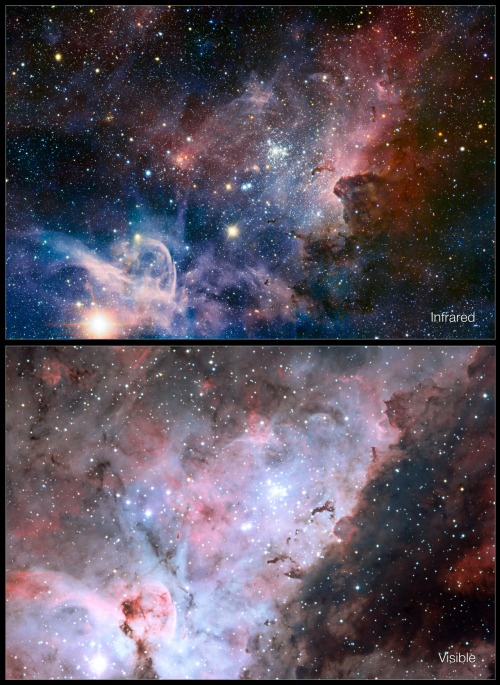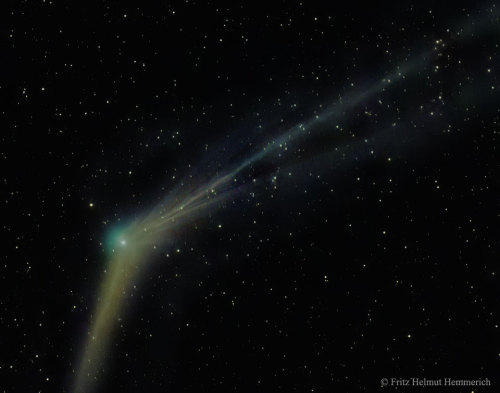Infrared/visible-light Comparison Of The Carina Nebula

Infrared/visible-light comparison of the Carina Nebula
js
More Posts from Littlecadet-biguniverse and Others

Enceladus, the sixth-largest moon of Saturn
js

Milky Way over Shelbyville, Indiana
js

Wide-field view of the sky around the exotic binary star system AR Scorpii
This wide-field image from the Digitized Sky Survey 2 shows the rich starfields surrounding the exotic binary star system AR Scorpii.
Credit: Digitized Sky Survey 2. Acknowledgement: Davide De Martin

New view of the Pillars of Creation - infrared
js

Blue bursts of hot young stars
js

The California Nebula.

Nebula NGC 3603
js


A ‘matryoshka’ in the interstellar medium
As if it were one of the known Russian dolls, a group of astronomers, led by researchers at the Instituto de Astrofísica de Canarias, (IAC) has found the first known case of three supernova remnants one inside the other. Using the programme BUBBLY, a method developed within the group for detecting huge expanding bubbles of gas in interstellar space, they were observing the galaxy M33 in our Local Group of galaxies and found example of a triple-bubble. The results, which were published yesterday in the journal Monthly Notices of the Royal Astronomical Society, help to understand the feedback phenomenon, a fundamental process of star formation and in the dissemination of metals produced in massive stars.
The group has been building up a data base of these superbubbles with observations of a number of galaxies and, using the very high resolution 2D spectrograph, GHaFaS (Galaxy Halpha Fabry-Perot System), on the 4.2 m William Herschel Telescope (WHT) of the Isaac Newton Group of Telescopes (Roque de los Muchachos Observatory, La Palma), has been able to detect and measure these superbubbles, which range in size from a few light years to as big as a thousand light years across.
Superbubbles around large young star clusters are known to have a complex structure due to the effects of powerful stellar winds and supernova explosions of individual stars, whose separate bubbles may end up merging into a superbubble, but this is the first time that they, or any other observers, have found three concentric expanding supernova shells.
“This phenomenon -says John Beckman, one of the co-authors on the paper- allows to explore the interstellar medium in a unique way, we can measure how much matter there is in a shell, approximately a couple of hundred times the mass of the sun in each of the shells”. However, if it is known that a supernova expels only around ten times the mass of the sun, where do the second and third shells get their gas from if the first supernova sweeps up all the gas?
The answer to that must come from the surrounding gas and in the inhomogeneous interstellar medium. “It must be -says Artemi Camps Fariña, who is first author on the paper-, that the interstellar medium is not at all uniform, there must be dense clumps of gas, surrounded by space with gas at a much lower density. A supernova does not just sweep up gas, it evaporates the outsides of the clumps, leaving some dense gas behind which can make the second and the third shells”.
“The presence of the bubbles -adds Artemi- explains why star formation has been much slower than simple models of galaxy evolution predicted. These bubbles are part of a widespread feedback process in galaxy disc and if it were not for feedback, spiral galaxies would have very short lives, and our own existence would be improbable”, concludes. The idea of an inhomogeneous interstellar medium is not new, but the triple bubble gives a much clearer and quantitative view of the structure and the feedback process. The results will help theorists working on feedback to a better understanding of how this process works in all galaxy discs.

Comet Catalina Emerges : Comet Catalina is ready for its close-up. The giant snowball from the outer Solar System, known formally as C/2013 US10 tails, making it an impressive object for binoculars and long-exposure cameras. The featured image was taken last week from the Canary Islands, off the northwest coast of Africa. Sky enthusiasts around the world will surely be tracking the comet over the next few months to see how it evolves. via NASA
js
-
 ainokaze liked this · 6 years ago
ainokaze liked this · 6 years ago -
 bi6money reblogged this · 6 years ago
bi6money reblogged this · 6 years ago -
 they-call-me-mr-anderson liked this · 6 years ago
they-call-me-mr-anderson liked this · 6 years ago -
 rileysfs liked this · 6 years ago
rileysfs liked this · 6 years ago -
 gtunesmiff reblogged this · 6 years ago
gtunesmiff reblogged this · 6 years ago -
 applezauce-deactivated liked this · 6 years ago
applezauce-deactivated liked this · 6 years ago -
 afterthedragonflies liked this · 6 years ago
afterthedragonflies liked this · 6 years ago -
 bottledandspilt liked this · 6 years ago
bottledandspilt liked this · 6 years ago -
 gtunesmiff liked this · 6 years ago
gtunesmiff liked this · 6 years ago -
 argle-bargling liked this · 6 years ago
argle-bargling liked this · 6 years ago -
 genocider-syo-is-still-my-queen liked this · 6 years ago
genocider-syo-is-still-my-queen liked this · 6 years ago -
 16fahri liked this · 6 years ago
16fahri liked this · 6 years ago -
 truthsinwhispers liked this · 6 years ago
truthsinwhispers liked this · 6 years ago -
 mindignored liked this · 6 years ago
mindignored liked this · 6 years ago -
 spnforevergirl liked this · 6 years ago
spnforevergirl liked this · 6 years ago -
 ajc18615425 liked this · 6 years ago
ajc18615425 liked this · 6 years ago -
 just-spacetrash liked this · 6 years ago
just-spacetrash liked this · 6 years ago -
 lucillaenchantress liked this · 6 years ago
lucillaenchantress liked this · 6 years ago -
 sharkspaceengine liked this · 6 years ago
sharkspaceengine liked this · 6 years ago -
 eat-a-friggin-snickers liked this · 7 years ago
eat-a-friggin-snickers liked this · 7 years ago -
 multisurface reblogged this · 7 years ago
multisurface reblogged this · 7 years ago -
 bullet-shot-heroes liked this · 8 years ago
bullet-shot-heroes liked this · 8 years ago -
 kromze reblogged this · 8 years ago
kromze reblogged this · 8 years ago -
 kromze liked this · 8 years ago
kromze liked this · 8 years ago -
 ladyknightofhollyrose reblogged this · 8 years ago
ladyknightofhollyrose reblogged this · 8 years ago -
 selpallax reblogged this · 8 years ago
selpallax reblogged this · 8 years ago -
 scribblings-of-a-madcap reblogged this · 8 years ago
scribblings-of-a-madcap reblogged this · 8 years ago -
 scribblings-of-a-madcap liked this · 8 years ago
scribblings-of-a-madcap liked this · 8 years ago -
 thestarspangledman liked this · 8 years ago
thestarspangledman liked this · 8 years ago -
 avi-availys reblogged this · 8 years ago
avi-availys reblogged this · 8 years ago -
 avi-availys liked this · 8 years ago
avi-availys liked this · 8 years ago -
 hextrudedcubes liked this · 8 years ago
hextrudedcubes liked this · 8 years ago -
 crownanother reblogged this · 8 years ago
crownanother reblogged this · 8 years ago -
 crownanother liked this · 8 years ago
crownanother liked this · 8 years ago -
 halfsentientgarbage liked this · 8 years ago
halfsentientgarbage liked this · 8 years ago -
 princeofspirits liked this · 8 years ago
princeofspirits liked this · 8 years ago -
 artemis25 liked this · 8 years ago
artemis25 liked this · 8 years ago -
 nightingalelost liked this · 8 years ago
nightingalelost liked this · 8 years ago -
 kudufawks liked this · 8 years ago
kudufawks liked this · 8 years ago -
 hannahs-moving-castle liked this · 8 years ago
hannahs-moving-castle liked this · 8 years ago -
 havaheart reblogged this · 8 years ago
havaheart reblogged this · 8 years ago -
 snetto liked this · 8 years ago
snetto liked this · 8 years ago -
 nuclearcarrots reblogged this · 8 years ago
nuclearcarrots reblogged this · 8 years ago -
 wheatbee reblogged this · 8 years ago
wheatbee reblogged this · 8 years ago -
 moonlight-on-a-mountain reblogged this · 8 years ago
moonlight-on-a-mountain reblogged this · 8 years ago
GREETINGS FROM EARTH! Welcome to my space blog! Let's explore the stars together!!!
144 posts